Catalogue > Liste par artiste
Parcourez la liste complète des artistes présentés dans le cadre des Rencontres Internationales depuis 2004. Utilisez le filtre alphabétique pour affiner vos recherches.
Laurie Thinot
Catalogue : 2008Xpression | Animation | dv | couleur | 3:20 | France | 2007
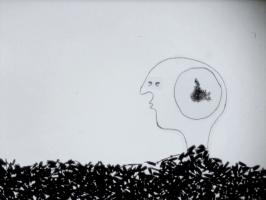
Laurie Thinot
Xpression
Animation | dv | couleur | 3:20 | France | 2007
Cheminement de pensée pour un face à face explosif nouveau synopsis: Un univers épuré, balayé par les vents. Soudain, le sol remue. Une tête au regard fixe émerge, à la façon d?un végétal. Puis une autre. Face à face. Ca y est, le décor est posé, les protagonistes sont là. Ils se dévisagent. A l?intérieur de l?esprit de l?un d?eux, une idée commence à prendre forme? et c?est la plongée. Bienvenue dans les méandres d?un laboratoire à pensées complètement délirant, peuplé de monstres et de bébés monstres ! Tout ceci débouchera-t-il sur un dialogue ?
Laurie Thinot naît à Paris en 1978. Après son bac, elle prend des cours de théâtre pendant 3 ans, puis entre en 2001 à L?ENSAD de Paris. Parallèlement, elle cumule des petits travaux de graphisme (affiche de pièce de théâtre, identités visuelles), participe à des expositions collectives, des stages et donne des coups de mains sur de petites productions d?animation en technique mixte (décor, story board). Elle réalise quelques films d?animation dans le cadre de ses études, s?oriente dans cette section et décroche son diplôme en 2006. X.pression est son film de fin d?étude. Sortie de l?école, elle fait du banc-titre sur le clip « I want love » de Jerho réalisé par Edouard Salier. Elle réalise son premier clip « La terre ferme » en technique mixte pour le groupe Luke en 2007.
Jennet Thomas
Catalogue : 2009The man who went outside | Installation vidéo | dv | couleur | 10:0 | Royaume-Uni | 2008
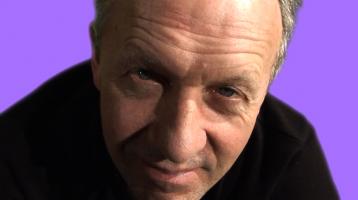
Jennet Thomas
The man who went outside
Installation vidéo | dv | couleur | 10:0 | Royaume-Uni | 2008
Un homme à l?aspect distingué (l?artiste Richard Layzell) est apparemment pris au piège dans un vide de couleur toujours changeant, enfermé dans un jeu de pouvoir avec une caméra utilisée de façon perverse. Présentateur de télévision, muet, prisonnier, et charismatique, il est tour à tour charmant, menaçant, instructif, confus. Parfois, il semble avoir de grands pouvoirs. Une voix-off nous dit des choses extraordinaires ? combien cet homme est vraiment spécial ? le premier homme à avoir un bébé. Des images de flashs hallucinogènes ponctuent le champ des couleurs pour nous donner une vision de la logique inquiétante et étrangement futuriste de son monde. Une critique science-fiction et rétro et de la représentation. Une méditation ludique sur l?idiotie de vouloir donner un sens aux choses.
Thomas Jennet est réalisatrice et membre fondateur du collectif londonien Exploding Cinema Collective. Son ?uvre est issue de la culture anarchiste et expérimentale du cinéma underground et de la scène alternative londonienne des années 1990. Son travail est diffusé les festivals de film à une échelle internationale, avec des rétrospectives récente aux Anthology Film Archives de New York (USA) et aux Rencontres Video Art Plastique en France. Plus récemment encore, ses ?uvres ont été exposées sous forme d?installation vidéo dans des galeries, à Londres (Royaume-Uni), en Europe et en Amérique du Nord, avec une récente exposition individuelle à PEER et une grande exposition à venir à la Matt?s Gallery de Londres. Son travail a débuté comme un hybride de performance verbale et de projections publiques ; il combine désormais une large variété de langages cinématographiques, allant du soap-opera à la réalisation de films expérimentaux et underground, de la science-fiction à la comédie musicale. Son travail aborde des sujets très humains et est souvent tristement comique.
Catalogue : 2008THE TRUTH AND THE PLEASURE | 0 | dv | couleur | 4:50 | Royaume-Uni | 2007
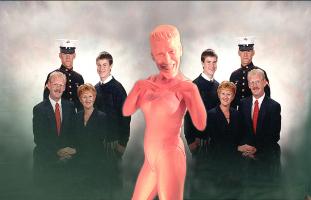
Jennet Thomas
THE TRUTH AND THE PLEASURE
0 | dv | couleur | 4:50 | Royaume-Uni | 2007
"J'installe une boite à outils à penser personnelle customiser seulement pour toi. Tu la mets en marche par le simple fait de cligner des yeux. A partir de maintenant, tes pensées vont êtres concentrées et vraies."
I live and work in London, and am a founder member of the Exploding Cinema Collective ( ww.explodingcinema.org) I am pathway leader of the Fine Art Time Based Media course at the University of the Arts London. My single screen work is distributed internationally by Video Data Bank www.vdb.org
Catalogue : 2007Because of the war | 0 | dv | couleur | 13:40 | Royaume-Uni | 2005
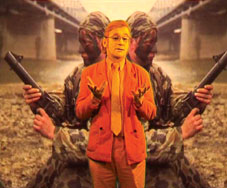
Jennet Thomas
Because of the war
0 | dv | couleur | 13:40 | Royaume-Uni | 2005
A cause de la guerre les choses changeaient. il ne restait que très peu de jouets et de jeux. la musique état presque finie. L'eau du robinet avait un goût de femme et la télévision s'allumait par spasmes...
mon travail est ma façon hybride de faire se rencontrer la culture pop, l'expérimental et les formes narratives. J'ai récemment présenté mon travail : Anthology Film Archives, New York, Centre d?Art Contemporain de Basse-Normandie, France The Gene Siskel Film Center, Chicago USA. je suis membre fondateur de EXPLODING CINEMA COLLECTIVE (www.explodingcinema.org) à Londres. mon travail est issu de la scène cinéma alternative londonienne des années 90. Mon travail solo est distribué à l'international par Data Bank www.vdb.org. J' enseigne au Wimbledon College of Art, et à la University of the Arts, London.
Catalogue : 2006Double Dummy | Vidéo expérimentale | dv | couleur | 6:40 | Royaume-Uni | 2004
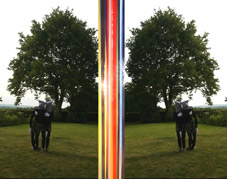
Jennet Thomas
Double Dummy
Vidéo expérimentale | dv | couleur | 6:40 | Royaume-Uni | 2004
Quatre mannequins, deux chats et un portail pour apporter la félicité dans leur tentative de symétrie. Une boule de cheveux, un mélange de brindilles dont l?amour est mort et qui sont tristes.
Mon travail a commencé à pousser à partir de la scène underground media de Londres dans les années 90 qui était animée par les artistes. Un membre fondateur du collectif Exploding Cinema basé à Londres dont j'avais visionné et projeté des films, ainsi que des vidéos et des installations,travaille sur le circuit de l?International Experimental Media Festival depuis 9 ans. Je vis dans le sud de Londres avec un réalisateur, Paul Tarrago, et Olive, son chat. Je suis un chargé de cours expérimenté au Wimbledon College of Arts à la University of Arts de Londres. Mes travaux vidéos sont distribués par la Video Data Bank à Chicago. Récemment, j?ai eu des rétrospectives de mes travaux dans plusieurs endroits : l'Anthology Film Archives de New York, le Centre d?Art Contemporain de Basse-Normandie et le Gene Siskel Film Center de Chicago aux Etats-Unis. Il y a aussi eu une tournée de mes travaux à la National Review of Lie Arts de Glasgow.
Nicolas Thomé Zetune, Felipe André Silva
Catalogue : 2026Minhas férias | Fiction expérimentale | 0 | couleur | 16:36 | Brésil | 2025
Nicolas ThomÉ Zetune, Felipe André Silva
Minhas férias
Fiction expérimentale | 0 | couleur | 16:36 | Brésil | 2025
« Je viens tout juste d’arriver du futur, et là-bas les gens vont encore au cinéma. En y repensant, il vaudrait peut-être mieux commencer ainsi : Je viens tout juste d’arriver du futur, et là-bas les gens vont encore au cinéma. »
Nicolas THOMÉ ZETUNE (1993, Brésil) est un réalisateur basé à São Paulo. En 2012, il fonde la société de production FILMES DE AMOR. Ses courts métrages ont été présentés dans certains des plus grands festivals internationaux, dont l’International Film Festival Rotterdam. Son premier long métrage, O Pequeno Mal, a été présenté au FID Marseille en 2018. Son deuxième film, O Tubérculo, a fait sa première mondiale au 27? Festival de Tiradentes. En 2025, Nicolas est sélectionné pour Berlinale Talents Buenos Aires, un forum international de discussion et de développement de projets organisé en partenariat avec la Berlinale et le BAFICI – Buenos Aires International Independent Film Festival. Il prépare actuellement son troisième long métrage, Invisible Tunnel, un projet sélectionné au FIDLab (Marseille, France). Le tournage est prévu pour novembre 2026. Felipe ANDRÉ SILVA (1991, Recife) est cinéaste et poète. Il a signé notamment les longs métrages Santa Mônica (2015) et Passado (2020), ainsi que le court Cinema Contemporâneo (2019). Il travaille régulièrement comme programmateur pour le festival Janela Internacional de Cinema do Recife. En littérature, il a publié les recueils o escritor Xerxenesky et o autocad de Britney Spears, et dirige actuellement &legal edições, une micro-maison d’édition numérique dédiée à la poésie contemporaine.
Justin Randolph Thompson
Catalogue : 2026From the Campidoglio to the Zoo | Film expérimental | super8 | couleur | 26:0 | Italie | 2023
Justin Randolph Thompson
From the Campidoglio to the Zoo
Film expérimental | super8 | couleur | 26:0 | Italie | 2023
From the Campidoglio to the Zoo est une œuvre filmique et sonore qui examine la persistance de la colonialité dans l’Italie d’après-guerre, en s’appuyant sur le Ponte Flaminio, un pont conçu pour célébrer les aspirations fascistes et offrir une entrée cérémonielle dans la ville, construit après la Seconde Guerre mondiale à partir de la proposition initiale d’Armando Brasini. Le titre de l’œuvre est emprunté à un essai inédit de l’écrivain William Demby, rédigé comme une critique du Deuxième Congrès des Artistes et Écrivains Noirs de 1959 auquel il avait assisté. Ce congrès, dédié au développement d’une vision et d’une solidarité entre producteurs culturels afro-diasporiques, existait en contraste direct avec son organisation par l’Istituto Italiano per l’Africa. Le film est activé par une performance sonore en direct, enregistrée au Museo delle Civiltà à Rome, par Dudu Kouate et Justin Randolph Thompson, puisant dans l’essence de la négritude avancée en relation avec le congrès et dans la nature fragmentaire de l’unité noire globale. Le son a été produit à partir d’une série d’instruments appartenant à la collection ethnographique du Musée Pigorini à Rome, conservée au Museo delle Civiltà. C’était la première fois que ces instruments étaient joués depuis leur intégration dans la collection, dans certains cas, depuis plus de cent ans. L’œuvre a été réalisée avec le soutien de la British School at Rome et du Museo delle Civiltà.
Justin Randolph Thompson est un artiste, facilitateur culturel et enseignant, né à Peekskill, dans l’État de New York, en 1979. Il partage sa vie entre l’Italie et les États-Unis depuis 1999. Thompson est lauréat d’un MAP Fund Award 2024, d’un Creative Capital Award 2022, d’une Italian Council Research Fellowship 2020, d’un Louis Comfort Tiffany Award, d’un Franklin Furnace Fund Award, d’une Visual Artist Grant de la Fundación Marcelino Botín, ainsi que d’une Emerging Artist Fellowship de Socrates Sculpture Park, entre autres distinctions. Ses œuvres et performances ont été largement présentées dans des institutions telles que le Whitney Museum of American Art, le Centro de Arte Reina Sofía, et The American Academy in Rome, et figurent dans de nombreuses collections, dont le Studio Museum in Harlem et le Museo MADRE. Sa vie et son travail cherchent à approfondir les discussions autour de la stratification socioculturelle et de l’« arrogance de la permanence », en mobilisant des communautés temporaires et fugitives comme formes monumentales, et en développant des projets reliant discours académique, activisme social et stratégies DIY de mise en réseau, au sein de rassemblements annuels ou biennaux, de partages et de gestes de collectivité.
Jon Thomson, Craighead, Alison
Catalogue : 2012A short film about war | Installation vidéo | hdcam | couleur | 9:39 | Royaume-Uni | 2010
Jon Thomson, Craighead, Alison
A short film about war
Installation vidéo | hdcam | couleur | 9:39 | Royaume-Uni | 2010
A Short film about War is a narrative documentary artwork made entirely from information found on the worldwide web. In ten minutes this two-screen gallery installation takes viewers around the world to a variety of war zones as seen through the collective eyes of the online photo sharing community Flickr, and as witnessed by a variety of existing military and civilian bloggers. As the ostensibly documentary `film` plays itself out, a second screen logs the provenance of images, blog fragments and gps locations of each element comprising the work, so that the same information is simultaneously communicated to the viewer in two parallel formats -on one hand as a dramatised reportage and on the other hand as a text log. In offering this tautology, we are attempting to explore and highlight the way in which information changes as it is gathered, edited and then mediated through networked communications technologies or broadcast media, and how that changes and distorts meaning -especially for (the generally wealthy minority of) the world`s users of high speed broadband networks, who have become used to the treacherously persuasive panoptic view that google earth (and the worldwide web) appears to give us.
Jon Thomson (b. London) and Alison Craighead (b. Aberdeen) are fascinated how globalisation and networked global communications have been re-shaping the way we all perceive and understand the world around us. They live and work in London and Kingussie in the highlands of Scotland making artworks and installations for galleries, museums and site-specific locations that include the worldwide web. Recent exhibitions include; Kumu Art Museum, Tallinn; Berkeley Art Museum, California; Highland Institute of Contemporary Art, Scotland; Artists Space, New York; Tang Contemporary, Beijing; Moderna Museet, Stockholm; and Dundee Contemporary Arts. Jon is Reader in Fine Art at The Slade School of Fine Art, University College London, while Alison is Reader in contemporary art and visual culture at University of Westminster and lectures in fine art at Goldsmiths University, London. For information on forthcoming, current and previous work, you can follow their blogat http://thomson-craighead.blogspot.com and explore their archive website at http://www.thomson-craighead.net
John Thomson
Catalogue : 2007Electronic Art Intermix | 0 | 0 | | 0:0 | USA | 2007
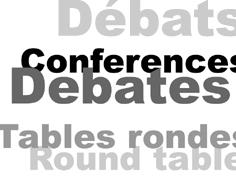
John Thomson
Electronic Art Intermix
0 | 0 | | 0:0 | USA | 2007
Electronic Arts Intermix (EAI) est l?un des plus importants centres mondiaux de ressources et de recherches sur l?art vidéo et les nouveaux médias. Fondé en 1971 par le galeriste new-yorkais Howard Wise, dont la galerie éponyme de la 57ème rue fut à une époque l?épicentre de l?art cinétique et des travaux multimédias, l?EAI avait pour objectif d?affirmer le rôle de la vidéo comme moyen de communication et d?expression artistique. En 36 ans d?existence, l?EAI a soutenu inconditionnellement les artistes et leurs travaux, jouant un rôle fondamental dans le développement de l?art vidéo, disséminant dans la monde plus de 3000 ?uvres réalisées par près de 175 artistes. Aujourd?hui, l?EAI se concentre sur la distribution et la préservation de sa phénoménale collection d??uvres. Une collection qui regroupe aussi bien des travaux historiques des pionniers de la vidéo que des ?uvres contemporaines d?artistes émergeants. Une collection, véritable mémoire des arts vidéos et nouveaux, disponible et consultable, en partie, sur le catalogue en-ligne de l?EAI (http://eai.org/). Mais si l?EAI soutient les artistes, en mettant notamment à leur disposition des outils digitaux et analogiques de montage, si l`EAI distribue et préserve son catalogue, l`organisation est avant tout un acteur culturel engagé, dans la promotion des arts nouveaux et dans leur vulgarisation. Elle met à disposition du public une salle de visionnage, où l?intégralité du catalogue est consultable. Elle organise des expositions et des programmes publics.
Depuis l?an 2000, John Thomson est Directeur de la Distribution de l?Electronic Arts Intermix (EAI). Il est aussi co-directeur et fondateur de Foxy Production, une importante galerie new-yorkaise d?art contemporain. Depuis les années 80, il est actif internationalement dans les arts nouveaux. Avant de déménager à New York en 2000, John Thomson effectuait des recherches sur la digitalisation et la distribution des arts multimédias au Lux Centre, à Londres. En 1998, il a été le coordinateur du Pandaemonium Festival à Londres et, en 1997, il a co-préparé la première exposition de l?Image en Mouvement du Lux Centre. Il a aussi organisé des programmes d?arts nouveaux et des expositions pour la Pacific Film Archive de Berkeley en Californie, pour la Staatsgalerie de Stuttgart, pour la Tate Britain à Londres, pour l?Institute of Contemporary Art de Londres, pour l?Exit Art à New York et pour le Smack Mellon à Brooklyn. Il a donné des conférences sur les arts nouveaux, à la London Institute et à la School of Visual Arts à New York, et a écrit pour des magazines (Mesh, à Melbourne, et l?Art In Culture, Séoul) et sur la préservation des arts nouveaux (Art Bewtween Zero and One : A Manual of Digital Art, Christoph Kehl et Beat Raeber, eds., Bâle).
Joshua Thorson
Catalogue : 2013Horizon | Fiction expérimentale | hdv | couleur | 13:0 | USA | 2011
Joshua Thorson
Horizon
Fiction expérimentale | hdv | couleur | 13:0 | USA | 2011
En 1982, à Walt Disney World de la Floride, était le vernissage de la Centre EPCOT, un peu retard pour un tel projet utopique moderniste. Le parc original présenté un manège appellé ?Horizons,? qui a été parrainé par GE. Elle a montré un avenir où la technologie et l`innovation couplée à l`unité de la famille allait évoluer dans des territoires passionnants, et jusque-là inimaginable?avec des colonies dans l`espace et dans le fond des océans de la Terre. En 2000, le manège a été démoli pour faire place à un manège à sensation immersive intitulée ?Mission: L`espace." L`histoire dans cette vidéo, d`une famille à faire des recherches scientifiques sur une colonie dans le complexe Chamaleon dont les livraisons et le financement inexplicablement cesser d`arriver, et qui est déterminée à survivre comme ils peuvent, accompagner archives séquences vidéo Hi-8 du trajet.
Joshua Thorson est un vidéaste et écrivain basé à New York. Il travaille avec le récit conceptuel, l`exploration et l`exploitation de l`échange narratif à travers les thèmes de la science, la religion, la transcendance, l`authenticité, l`idéalisme, et les traumatismes. Utilisation décalages tonal et l`économie rigoureuse, cet ouvrage cherche à la fois à répondre aux attentes et usurpent, l`ouverture de «l`histoire» de l`ontologie. Thorson a présenté son travail dans les musées, galeries et théâtres à l`étranger.
Lena Maria Thuering
Catalogue : 2010Das Haus | Vidéo | dv | couleur | 11:0 | Suisse | 2008
Lena Maria Thuering
Das Haus
Vidéo | dv | couleur | 11:0 | Suisse | 2008
?The father shoots the first wild boar, it is being decomposed and skinned in the basement and hung in the laundry. 20 cents costs a glimpse on the shot animal. The nanny has to clean the wild boar teeth and to put them in a box.? What defines memory and what exactly does it set about? In Lena Maria Thüring?s video work ?The House? half a century of family history is reflected upon a detached house?s empty walls: Slowly and continuously the camera runs through hallways, rooms, and the staircase, while a background voice narrates the past. Thüring?s interaction with time and space in the film consecutively plays with the expectations of the observer and questions the relationship between documentation and fiction. By objectification of word and vision in the formal realisation, Thüring hence confronts the viewer with his own past. Annette Amberg
Lena Maria Thüring is born 1981 in Arlersheim, BL, Switzerland her native place is Basel, BS, Switzerland. She lives and works in Zürich, Switzerland. 2002 Artistic preparatory course at the School of Art Zurich, Zurich 2002?2007 Photography at the School of Art Zurich, Zurich since 2005 partial artistic cooperation with Annette Amberg.
Georg Tiller
Catalogue : 2012Vargtimmen - Nach einer Szene von Igman Bergman | Film expérimental | 16mm | noir et blanc | 6:20 | Autriche | 2010
Georg Tiller
Vargtimmen - Nach einer Szene von Igman Bergman
Film expérimental | 16mm | noir et blanc | 6:20 | Autriche | 2010
Vargtimmen?After a Scene by Ingmar Bergman is the exact reconstruction of a scene in Bergman?s 1968 film of the same name. Frame for frame, Georg Tiller and his cameraman Claudio Pfeifer reproduced the same shots?with the crucial difference that no actors are visible. All we see are the ocean and cliffs in black and white, steep rock formations, and with them the quiet surface of the water, ruffled slightly by the breeze. The soundtrack, which had no dialogue in the original either, was taken from the first film and adds narrative structure to the lonely landscape. While in Vargtimmen Bergman concentrated on the faces of people, the focus of Tiller?s film experiment is space, and nature. The camera glides over the barren countryside, and stone slabs with numerous cracks and gaps lie in the sun, providing a stark contrast with the velvety smooth, nearly black water. In Bergman?s film a nightmarish drama plays out before this background: In a frenzy, a man kills a boy, then lets the lifeless body slip into the water. Without human figures, the space itself becomes an actor. The camera examines the section of coastline from a number of different angles, includes the horizon to add a painterly touch, then the cliffs loom threateningly into the sky again. The music gives these images of empty countryside a dramatic arc, the tragedy in the original story can be sensed. At the same time the filmic representation of the landscape enters the foreground, like an empty stage becoming a projection screen. Tiller has created a study, and its conceptual rigor opens up a broad field of associations involving perception, representational forms and the construction of filmic space. (Andrea Pollach) Shot for Shot reconstruction of a scene from the film Vargtimmen (1968) by Ingmar Bergman using the same technical devices - Lenses, Framing, Length of Shots as well as movements of the Camera. The absence of the bodies of the actors opens the room for a complete concentration on the filmic space. This reconstruction is understood as a reenactment by the reconstructeur, a becoming of Ingmar Bergman, thus reenacting a specific style of directing.
Born 1982 in Vienna. Studied Philosophy and Russian at the University of Vienna, since 2000 at the Academy of Fine Arts, Vienna. Studied from 2005-2006 at the University of Music and Performing Arts Vienna, dept. film and television. Studies since 2006 at the Academy of Film and Television, Berlin.
Aidan Timmer
Catalogue : 2026Tarik en Ik | Doc. expérimental | 4k | couleur | 21:48 | Pays-Bas, Belgique | 2025
Aidan Timmer
Tarik en Ik
Doc. expérimental | 4k | couleur | 21:48 | Pays-Bas, Belgique | 2025
En revisitant les images d’un détournement survenu lors du journal télévisé national néerlandais, en 2015, Aidan Timmer, qui a désormais le même âge que l’auteur des faits, réfléchit à cet événement. En regardant le jeune homme peiner à réciter une lettre en direct à la télévision, Aidan se rapproche émotionnellement du garçon qui avait pris son père en otage.
Aidan Timmer (né à Amsterdam, Pays-Bas) développe un travail principalement ancré dans le champ audiovisuel. Il s’est plongé de plus en plus profondément dans le documentaire, l’essai filmique et les formes hybrides. La plupart de ses films ou de ses œuvres naissent d’une fascination obsessionnelle pour tout ce qui tente de transmettre une vérité ou une forme de véracité. Il envisage ses films comme des explorations essayistiques de l’objectivité et de l’illusion d’impartialité. Tarik en Ik met en scène la relation émotionnelle et obsessionnelle avec une peur issue du passé.
Zanic Tin
Catalogue : 2021Antiotpad | Fiction | dcp | | 18:6 | Croatie | 2020
Zanic Tin
Antiotpad
Fiction | dcp | | 18:6 | Croatie | 2020
La voiture de quelqu'un est en feu. Quelqu'un s'est fait défoncer la tête. Quelqu'un s'est fait voler son portable. L'adolescent perturbateur rompra-t-il le cercle vicieux de violence, qu'il a peut-être déclenché lui-même?
Tin Žani? a obtenu un Master en réalisation de fiction à la NFTS - National Film and Television School, Beaconsfield (Royaume-Uni), en tant que boursier du Croatian Audiovisual Centre, Zagreb (Croatie). Avant d’aller à la NFTS, il a complété une Licence en production cinématographique et théâtrale à Zagreb (Croatie). Ses deux premiers films courts, "Komba" (2011) et "Manja?a" (2014), ont reçu des prix et des mentions spéciales, et ont été présentés dans des festivals de cinéma, ainsi que des festivals et marchés du film de premier plan, notamment au Festival international du film de Rotterdam (Pays-Bas); au Festival international du court métrage de Clermont-Ferrand (France); au Tampere Film Festival, Tampere (Finlande); au Sarajevo Film Festival (Bosnie-Herzégovine); au Internationales Kurtzfilm Festival Hamburg, Hambourg (Allemagne); et au Zagreb Film Festival (Croatie).
Thadeusz Tischbein
Catalogue : 2018Schneewittchen (Snow White) | Vidéo | hdv | couleur et n&b | 19:40 | Allemagne | 2017
Thadeusz Tischbein
Schneewittchen (Snow White)
Vidéo | hdv | couleur et n&b | 19:40 | Allemagne | 2017
What role can culture play, when dead bodies are not burried after death, but being used for other purposes “Snow White” examines this question, using stalinist Mausoleums, preparated animals in Natural History Museums and relics in churches. What form of story telling is being used to hide actions and translate them?
Thadeusz Tischbein is a Germany-based video artist. He studied between 2008 and 2016 in Leipzig, Braunschweig (Germany) and Bucharest (Romania) with Candice Breitz, Clemens von Wedemeyer and Günther Selichar. His 2017 video essay SNOW WHITE (2K Cinemascope, 19:40 min) is a journey to the dead bodies in mausoleums, churches and museums. In THE ATLAS OF THE WOUNDED BUILDINGS (HD, 12:56 min, 2016) he is trying to examine narrations written in bullets holes. INVENTORY (HD, 16:9, 5:49 min) from 2015 is talking about the strange living room of so called office plants.
Benjamin Tiven
Catalogue : 2014A Third Version of the Imaginary | Installation vidéo | | couleur | 12:0 | USA, Kenya | 2012
Benjamin Tiven
A Third Version of the Imaginary
Installation vidéo | | couleur | 12:0 | USA, Kenya | 2012
A Third Version of the Imaginary traces an encounter with the video and film library of the Kenya Broadcasting Corporation in Nairobi. We follow the station?s librarian through tightly-packed shelves of video cassettes: he is searching for a specific image, and must sift through the identifying paperwork from a number of tapes. As he methodically moves among the stacks, a Swahili voice-over speaks about the arrival of video technology in Kenya and its impact on the archiving of television images: video may have cheapened production, but its material expense put pressure on storage. Later, the librarian converts a basement storage closet into a makeshift cinema, in order to screen some 16mm film material. The voice-over shifts accordingly, moving from video to film, and to the linguistic problem posed by the very word ?image? in Swahili. A visual and narrative echo chamber, this video addresses video?s address of film: the material facts of these media become the aesthetic facts of the work.
Benjamin Tiven lives and works in Brooklyn, New York, US. Forthcoming exhibitions, 2014: ICA Philadelphia (solo); gallery 1/9 Unosunove, Rome, IT (in collaboration); Courtisane festival, Ghent, Belgium. Recent exhibitions: Henningsen Gallery, Copenhagen, DN; Westfälischer Kunstverein, Münster, DE; Charlottenborg Kunsthal, Copenhagen; Bronx Museum of Art, Bronx, NY; Vivo Media Arts Center, Vancouver; Center for Curatorial Studies at Bard College. Recent film screenings: Rotterdam International Film Festival; Migrating Forms, NY; Museum of the Moving Image, NY; Cinéphémère, FIAC, Paris, FR; Vienna International Film Festival, AT; Arsenal Cinema, Berlin, DE; FID Marseille, FR; RIDM Festival, Montreal, QB; Oberhausen Short Film Festival, DE; 25FPS Festival, Zagreb, HR; Images Festival, Toronto, ON. Journal contributions: Triple Canopy, Nka: Journal of Contemporary African Art, Bidoun, Bulletins of the Serving Library, Roulotte issue #10, ACM, Barcelona, ESP. Public presentations, 2013: the Drawing Center; the Colloquium for Unpopular Culture, Westfälischer Kunstverein.
Benjamin Tiven
Catalogue : 2019The Mirrored Message | Doc. expérimental | hdv | couleur | 12:30 | USA, Suède | 2018
Benjamin Tiven
The Mirrored Message
Doc. expérimental | hdv | couleur | 12:30 | USA, Suède | 2018
The Mirrored Message documents two scientists as they prototype a new device that transfers data between wireless computer networks and living plants. Observing their work from within a sealed electronics facility near Stockholm, we follow procedural steps in the device's programming and fabrication. The initially alien laboratory space slowly reveals itself as a kind of photographic darkroom, and we watch the light-sensitive production of the device's specialized circuitry. From the artificial air of this controlled lab we move to a coastal forest near the Baltic Sea, where the transmitter is installed for testing. Weather impedes the work. As the humans slowly fade from the scene, a living specimen comes online, finally addressable by a local network.
Benjamin Tiven is a filmmaker and the co-director of Library Stack. His films have screened at FID Marseille, Viennale, Rotterdam, Oberhausen, Courtisane, MUMOK, the Institute of Contemporary Art, Philadelphia, Delfina Foundation, London, Fotografisk, Copenhagen, the Museum of the Moving Image, NYC, and Arsenale Kino, Berlin.
Alain Tjiong
Catalogue : 2014Voyeur | Fiction expérimentale | | couleur | 19:52 | Pays-Bas, Belgique | 2013
Alain Tjiong
Voyeur
Fiction expérimentale | | couleur | 19:52 | Pays-Bas, Belgique | 2013
SYNOPSIS Out of the black night she emerges. Her waving soft fair hair reminds the glamour of the Hitchcock blondes. Her pale skin fragile like a china doll. She turns her head and looks at us.
BIOGRAPHY Alain Tjiong (The Netherlands, 1991) is currently a master student film at the School of Arts (KASK) in Ghent, Belgium. His films are first and foremost a means of personal expression, a way to communicate his feelings and his thoughts with a audience. While still operating in the field of narrative fiction, he is always searching for the bounderies of narrative cinema and trying to rediscover its (lost) relevance.
Robert Todd
Catalogue : 2018Restless | Film expérimental | 16mm | noir et blanc | 0:0 | USA | 2016
Robert Todd
Restless
Film expérimental | 16mm | noir et blanc | 0:0 | USA | 2016
Changing winds, shifting moods, stirring, awaiting…
A lyrical filmmaker as well as a sound and visual artist, Robert Todd continually produces short works that resist categorization. In the past twenty years he has produced a large body of short-to-medium format films that have been exhibited internationally at a wide variety of venues and festivals including the Media City Festival, San Francisco International Film Festival, Rotterdam International Film Festival, New York Film Festival, Le Rencontres Internationale, Black Maria Film Festival, Nouveau Cinema in Montreal, Cinematheque Ontario, the Harvard Film Archive, Pacific Film Archive, the Paris Biennial, Slamdance Film Festival, and others. His films have won numerous festival prizes, grants, and artist’s awards. He teaches film production at Emerson College in Boston.
Rob Todd
Catalogue : 2017Phases of Noon | Film expérimental | 16mm | noir et blanc | 11:25 | USA | 2016
Rob Todd
Phases of Noon
Film expérimental | 16mm | noir et blanc | 11:25 | USA | 2016
Watching four species of paradise perform in four phases of noonlight reflecting on four film rolls, in four acts
A lyrical filmmaker as well as a sound and visual artist, Robert Todd continually produces short works that resist categorization. His visually stunning body of work, which comes from a deeply personal place, takes a variety of poetic approaches to looking at the personal, political, and social ways in which we choose to live. His films have been exhibited internationally at a wide variety of venues and festivals. He teaches film production at Emerson College.
Catalogue : 2016ICE | Film expérimental | 16mm | noir et blanc | 9:0 | USA | 2015
Rob Todd
ICE
Film expérimental | 16mm | noir et blanc | 9:0 | USA | 2015
Following the feel of black and white rising and falling through caverns and across plains.
A lyrical filmmaker as well as a sound and visual artist, Robert Todd continually produces short works that resist categorization. His visually stunning body of work, which comes from a deeply personal place, takes a variety of poetic approaches to looking at the personal, political, and social ways in which we choose to live. His large body of short-to-medium format films have been exhibited internationally at a wide variety of venues and festivals. He teaches film production at Emerson College.
Catalogue : 2015LoveSong | Film expérimental | 16mm | couleur et n&b | 6:0 | USA | 2014
Rob Todd
LoveSong
Film expérimental | 16mm | couleur et n&b | 6:0 | USA | 2014
Threads, strings, love`s touch attuned, rising like the dawn in song.
A lyrical filmmaker as well as a sound and visual artist, Robert Todd continually produces short works that resist categorization. His visually stunning body of work, which comes from a deeply personal place, takes a variety of poetic approaches to looking at the personal, political, and social ways in which we choose to live. His large body of short-to-medium format films have been exhibited internationally at a wide variety of venues and festivals. He teaches film production at Emerson College.
Catalogue : 2014Free-Forms | Film expérimental | 16mm | noir et blanc | 7:0 | USA | 2013
Rob Todd
Free-Forms
Film expérimental | 16mm | noir et blanc | 7:0 | USA | 2013
A small universe unbound.
A lyrical filmmaker as well as a sound and visual artist, Robert Todd continually produces short works that resist categorization. His visually stunning body of work, which comes from a deeply personal place, takes a variety of poetic approaches to looking at the personal, political, and social ways in which we choose to live. His large body of short-to-medium format films have been exhibited internationally at a wide variety of venues and festivals.
Catalogue : 2013Habitat | Film expérimental | 16mm | noir et blanc | 10:0 | USA | 2012
Rob Todd
Habitat
Film expérimental | 16mm | noir et blanc | 10:0 | USA | 2012
Locations that shift, split and spill over one another like sand in an hour glass. This is my world. A graphically-oriented spatial portrait, an in-camera layered tapestry: inversions and conversions that mark time with the chaos of my waking work-life, diffusing as it moves inward.
A lyrical filmmaker as well as a sound and visual artist, Robert Todd continually produces short works that resist categorization. His visually stunning body of work, which comes from a deeply personal place, takes a variety of poetic approaches to looking at the personal, political, and social ways in which we choose to live. His large body of short-to-medium format films have been exhibited internationally at a wide variety of venues and festivals.
Catalogue : 2011Rayning | Film expérimental | 16mm | noir et blanc | 6:0 | USA | 2010
Rob Todd
Rayning
Film expérimental | 16mm | noir et blanc | 6:0 | USA | 2010
Light rayns-rains-reigns across a dream of tranquility that thickens, darkens and evaporates.
A lyrical filmmaker as well as a sound and visual artist, Robert Todd continually produces short works that resist categorization. In the past twenty years he has produced a large body of short-to-medium format films that have been exhibited internationally at a wide variety of venues and festivals and have won numerous festival prizes, grants, and artist?s awards. He teaches film production in the Boston area, and works as editor, sound designer/editor, post-supervisor or music producer on various broadcast and theatrically-released productions.
Catalogue : 2009cabinet | Film expérimental | 16mm | couleur et n&b | 10:0 | USA | 2007
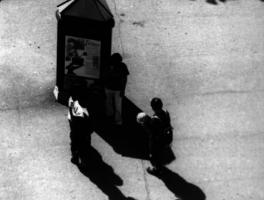
Rob Todd
cabinet
Film expérimental | 16mm | couleur et n&b | 10:0 | USA | 2007
Une salle destinée à l'exposition d'objets ou ?uvres d'art. Une vue dans, à travers, et à partir, d'un ensemble de « cabinets », récipients à la fois actifs et passifs. Le film se penche sur ce qui rend possible l?intimité dans la médiatisation, grâce à une étroite attention aux mouvements, aux contours, aux textures et aux couleurs des objets et des scénarios proches du réalisateur. L?instable sentiment de présence ressenti entre le sujet, le spectateur, l?auteur et la machine est ce qui anime les transformations visuelles de ce film.
Robert Todd réalise des courts-métrages dans la région de Boston depuis 1990. Son corpus d??uvres, visuellement étonnantes et difficilement définissables ou classables, provient d?un lieu très personnel, calme, réfléchi, et curieux. Ses films empruntent diverses approches poétiques pour examiner les manières personnelles, politiques et sociales avec lesquelles nous choisissons de vivre.
Brad Todd
Catalogue : 20223050 K | Vidéo | mp4 | couleur | 9:27 | Canada | 2021
Brad Todd
3050 K
Vidéo | mp4 | couleur | 9:27 | Canada | 2021
3050 K is an AI/Neural Net project which utilizes imagery of stage lighting (floods, spots, footlights, gels) sourced from 70 concerts and performances of rock music from the 1970’s. These images are in turn used as primary material for a Neural Net and provide the training model for the resultant imagery. The images which are generated from this process are visualizations of emergent forms and tableau which are the offspring of the original material. These images are then re-processed and provide the individual frames for a video representation of the GAN’s procedural and generative algorithmic creation. The hypnotic and somnambulant visuals are accompanied by a score I created, composed of a number of heavily processed aural artifacts from the era. The title ’3050 K’ is in reference to the average number of Kelvins used in stage and theatrical lighting.
Brad Todd is an artist whose works span several fields of inquiry, principally involving the research/creation of responsive environments which implicate technology as a mirror, filter and catalyst for experience writ large in both an individually embodied sense and its attendant broader socio-political context. Recent and past projects have focused on issues of visualizing and conditioning invisible, abstract and liminal material such as EMF, infrasonics, aggregate data and microclimates, while in other works the content is more explicit and political. Having received an M.F.A. from Concordia University (Montréal), he began playing music in the post-punk band Sofa, which released the inaugural album and single on the Constellation Records label. From the generative and reactive to the composed and performative, audio and sound design continues to play a key role in his works. Brad has received numerous grants and awards and has exhibited his works in galleries and media festivals in North America, South and Central America, Asia and Europe. Presently he is an instructor in the Design and Computation Arts program at Concordia University in Montréal.
Vladimir Todorovic
Catalogue : 2010the snail on the slope | Animation | dv | noir et blanc | 7:42 | Serbia, Singapour | 2009
Vladimir Todorovic
the snail on the slope
Animation | dv | noir et blanc | 7:42 | Serbia, Singapour | 2009
The Snail on the Slope is a generative movie based on a book of the same title by Strugatsky brothers. The novel is set on an unknown planet, where humans have a base from which they are investigating and trying to conquer the Forest. The Forest, which is a huge single organism is constantly changing and fighting back. It is also dangerous and there are a lot of unexplained phenomena that they are discovering, frequently. The movie is made of five chapters, which critically address the questions of artistic and scientific efforts to understand nature. The topics that arise in those chapters and that are rendered in semiotic relationship with nature are: sublime view, role of knowledge, escape from ubiquitous bureaucracy, and apocalyptic tone that comes with the destruction of nature. By applying an organic narrative structure to the generative dynamic forms, a spectator witnesses a definition of a novel cinematic experience. In the movie, all the scenes are generated with computer programming language Processing. They are created as abstractions and visualizations of the atmospheres in which all of the action takes place. The music is generated with various analog, digital synthesizers and software instruments.
Vladimir Todorovic, born 1977. Zrenjanin (Serbia), studied visual arts, at the Academy of the Arts in Belgrade and University of California Santa Barbara. Currently, he is working as Assistant Professor at the School of Art, Design and Media, NTU, Singapore. He co-founded the new media art collective called ʻsyntfarmʼ based in Singapore and the Institute for Flexible Cultures and Technologies `NAPON` in Novi Sad, Serbia. His research and art practice focus on generative art forms that are defining novel approaches in new media art and design. In his work, generative forms are utilized in the development of media performances and installations. They are used in various media including: generative video, audio-visual installation and performance, rapid-prototypes, computer games, mixed-reality systems, nano-fabrication, and various others. His projects were exhibited at events and venues like: ICA Singapore, ISEA08, Wired NextFest, Dislocate07, Enter3, ISEA06, Siggraph 06, Transmediale 05, File 2004, MuseumsQuartier Vienna, Machinista, Entermutlimediale 2, WRO05 Biennale, Museum of Contemporary Arts Belgrade, etc; and reviewed at/by: Channel NewsAsia, Reuters, ?Smart Surfaces? ? Springer/Birkhäuser, Wired, New Scientist, Gamasutra, Futures-labs, Neural.it, Res Magazine, Selectparks.net, Turbulence, Artmagazine, Remont, Danas, etc. Recently, he served as the chair of Ludic Interfaces theme and the organizer of ISEA08 in Singapore.
Jenni Toikka
Catalogue : 2023Prelude Op. 28 No. 2 | Film expérimental | 16mm | couleur | 8:25 | Finlande | 2022
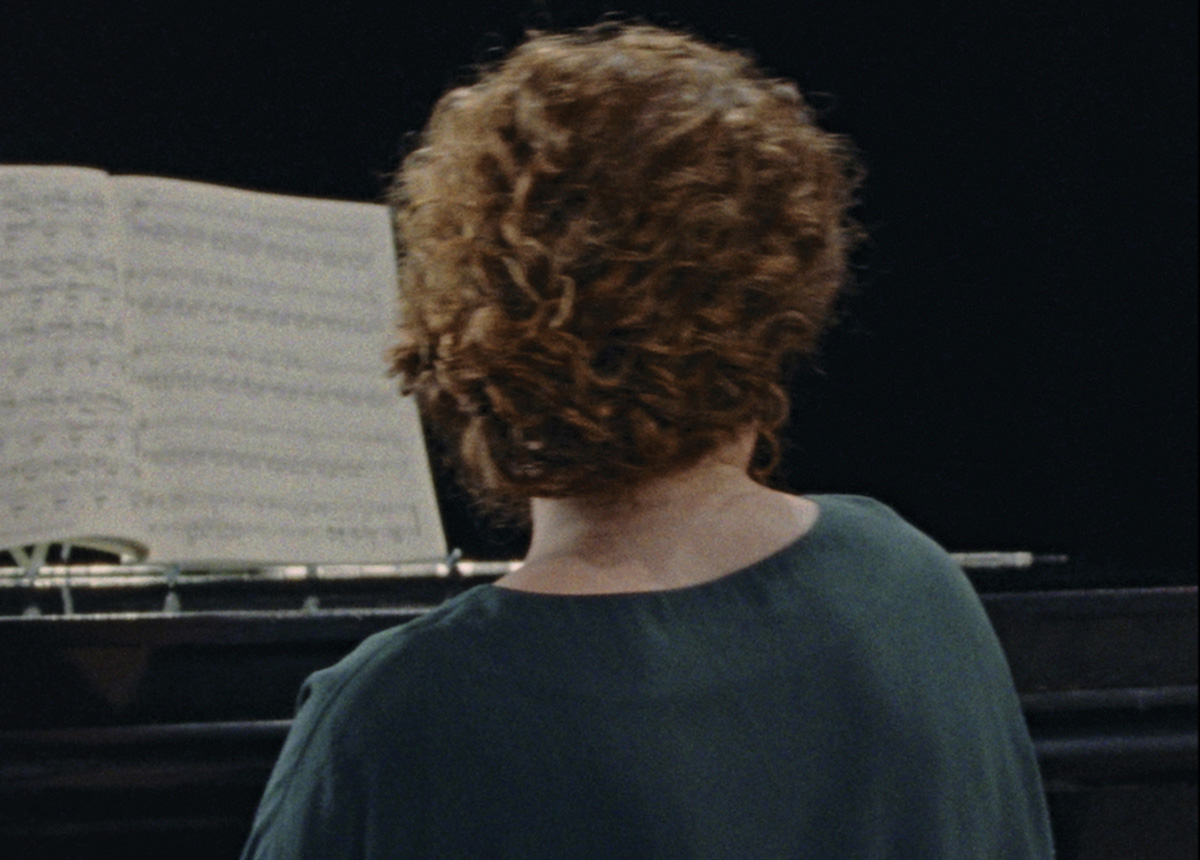
Jenni Toikka
Prelude Op. 28 No. 2
Film expérimental | 16mm | couleur | 8:25 | Finlande | 2022
During a single long shot, we see two people taking turns playing the piano and listening alternately. The piece is the same on both times - Preludi Op. 28 No. 2 by Chopin - but when the performer changes, the interpretation of the song changes along with the perspective from which the song and its performance are viewed. The uninterrupted playing and single shot capture the event in one temporal moment, but as the camera moves and two people change places, time is equally layered. The performer becomes the listener and the listener becomes the performer. In one of the key scenes of Ingmar Bergman's Autumn Sonata (1978), the mother and daughter take turns playing the very same Chopin's Prelude. It is a piece that both are familiar with, so they are able to settle into the position of the other as they listen and watch the other play. A situation like this raises questions about the sense of reciprocity, simultaneity and synaesthesia. Could the roles become mixed from viewer and listener to the object of the gaze and listening? When watching the other playing, can you feel your own hands and fingers on the keys?
Jenni Toikka (b. 1983) is a Helsinki-based visual artist working predominantly with moving images. Toikka graduated from the Academy of Fine Arts, Helsinki in 2012. She has had several solo exhibitions in Helsinki including at Sinne, Forum Box and Kluuvi Gallery. In autumn 2019, her work was shown in the solo exhibition Reel at HAM – Helsinki Art Museum. Jenni Toikka’s video pieces have been seen internationally in group exhibitions and at festivals. Her work is represented in the collections of the Saastamoinen Foundation, Espoo Modern Art museum EMMA and the Museum of Contemporary Art Kiasma.
Yan Tomaszewski
Catalogue : 2020The Good Breast and the Bad Breast | Documentaire | 4k | couleur | 22:22 | France | 2019
Yan Tomaszewski
The Good Breast and the Bad Breast
Documentaire | 4k | couleur | 22:22 | France | 2019
2002, Palm Springs, Californie : une incroyable maison d’architecte est rasée au bulldozer par un individu qui venait de l’acheter 2,5 millions de dollars. Construit en 1962, ce "bijou moderniste" situé sur un majestueux terrain de golf en plein désert, fut conçu par Richard Neutra pour héberger une grande collection d’art moderne et contemporain. En puisant dans l’intérêt de Neutra pour la psychanalyse et dans les rumeurs d’une vendetta personnelle de l’acheteur, le film mène l’enquête sur notre désir de protéger et de détruire la beauté. En écho à la théorie psychanalytique de Melanie Klein, la maison devient l’incarnation du bon sein encourageant et protégeant la créativité, tandis que l’acheteur incarne l’envie du mauvais sein destructeur.
Yan Tomaszewski est un artiste franco-polonais travaillant à la croisée de la sculpture, de l’installation et du cinéma. Son travail a été présenté lors d’expositions personnelles, notamment au Musée Archéologique de Cracovie (PL), au Musée de l’Air et de l’Espace au Bourget (FR), au Centre d’art contemporain Kronika à Bytom (PL), au Middelheim Museum à Anvers (BE), à la galerie Asymetria à Varsovie (PL) ou à Primo Piano à Paris (FR). Il a participé à de nombreuses expositions collectives, notamment à Artience (Daejeon, KR), au Fresnoy Studio national des arts contemporains (Tourcoing, FR), au Prix Sciences Po pour l’art contemporain (Paris, FR), à la Galerie municipale Arsenal (Poznan, PL), à Chapter II (Séoul, KR), à la Fondation Hippocrène (Paris, FR), à Chalet Society (Paris, FR) au Centre Pompidou (FR), à Manifesta 9 (Genk, BE), à la Saline Royale d’Arc et Senans (FR). Ses films ont été présentés au FID Marseille (FR) et à DocLisboa (PT).